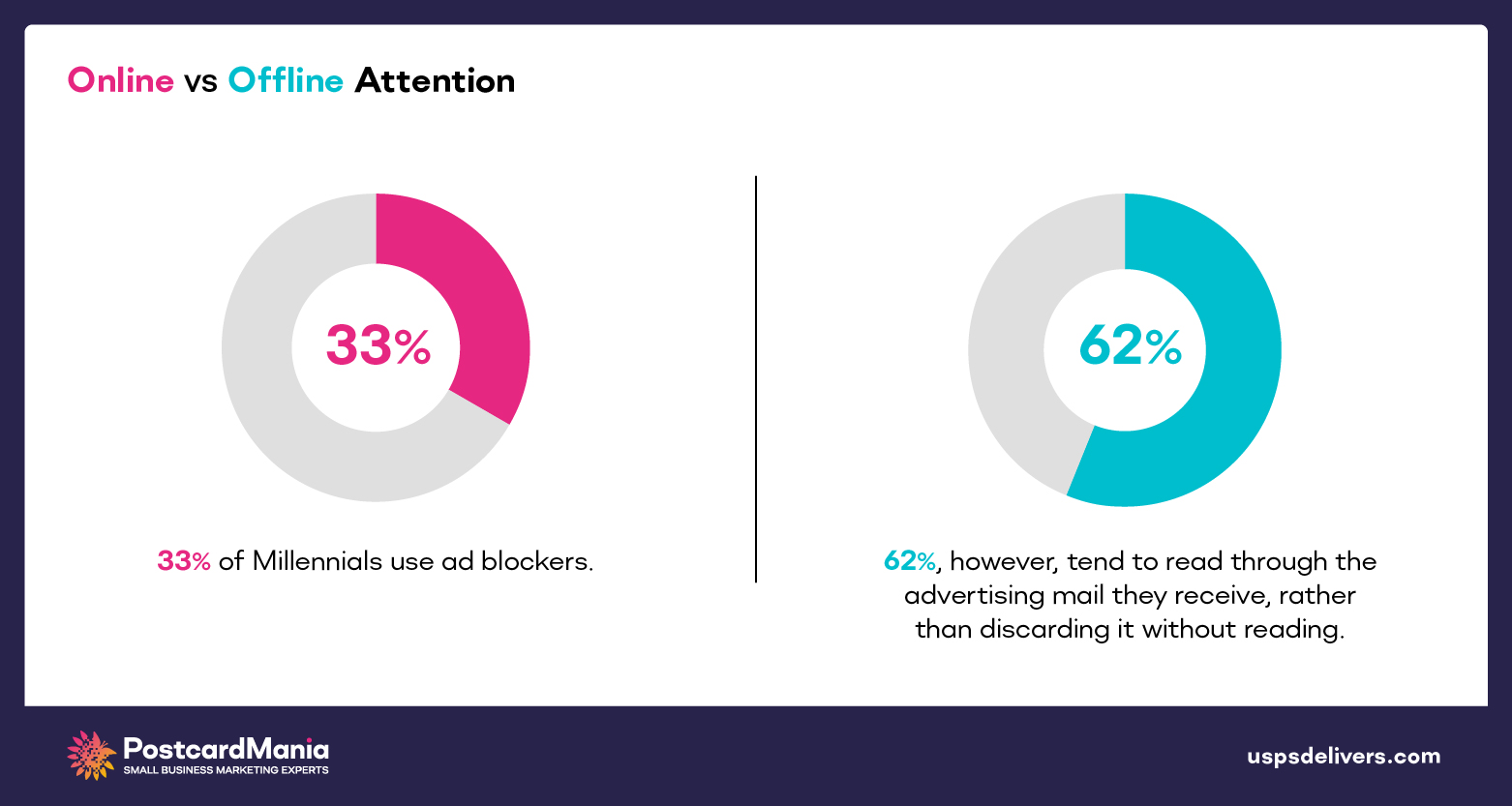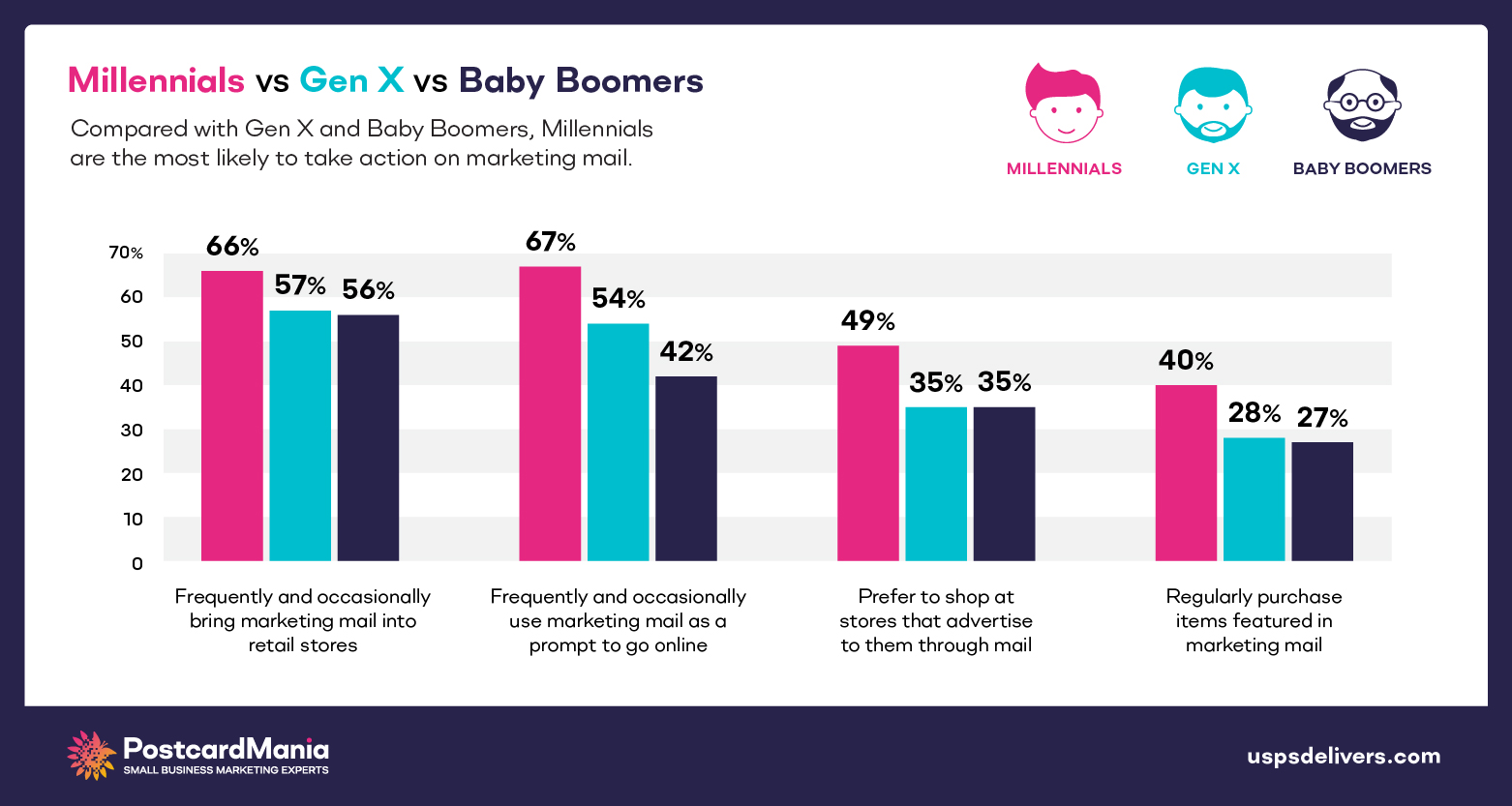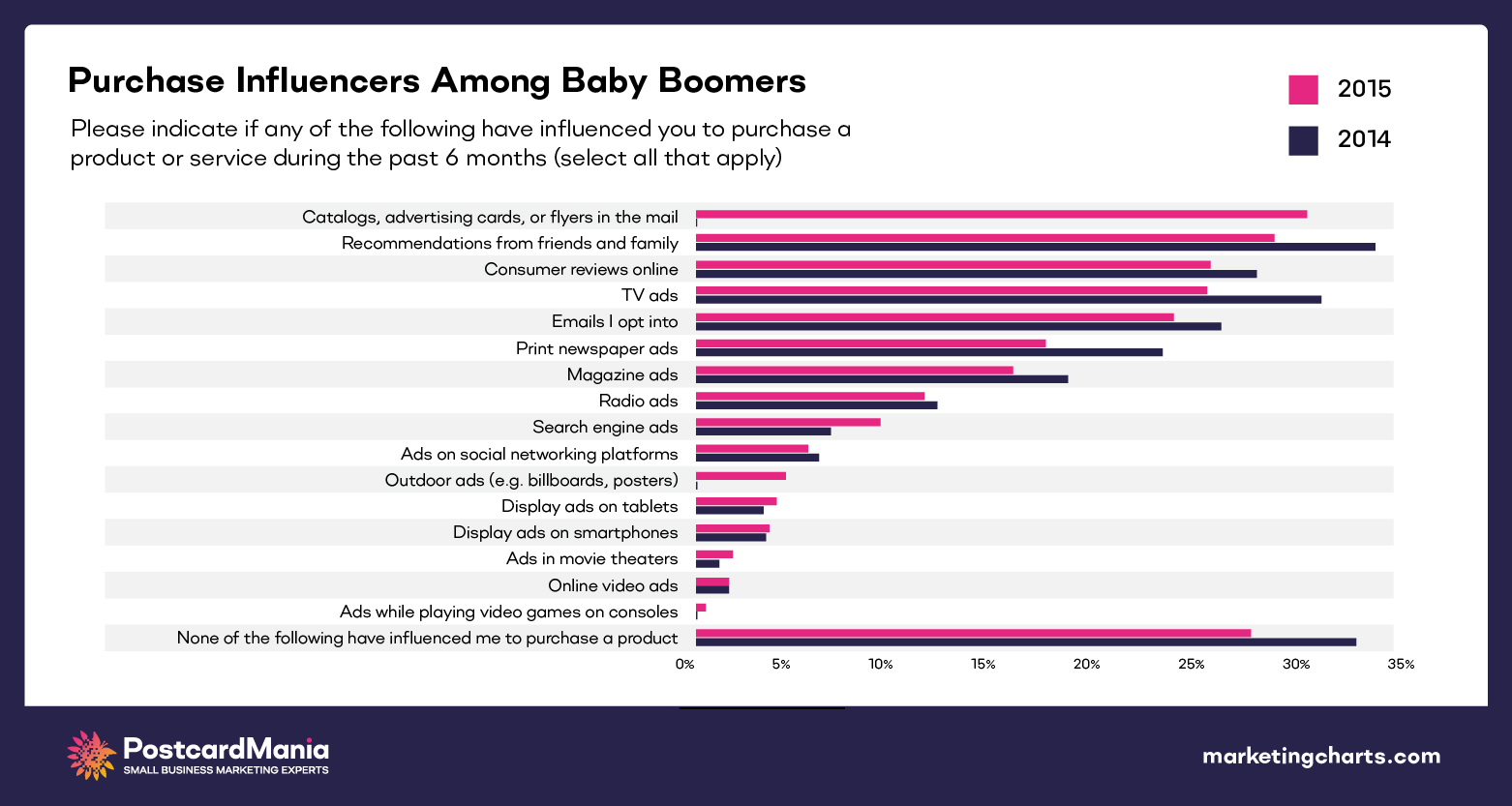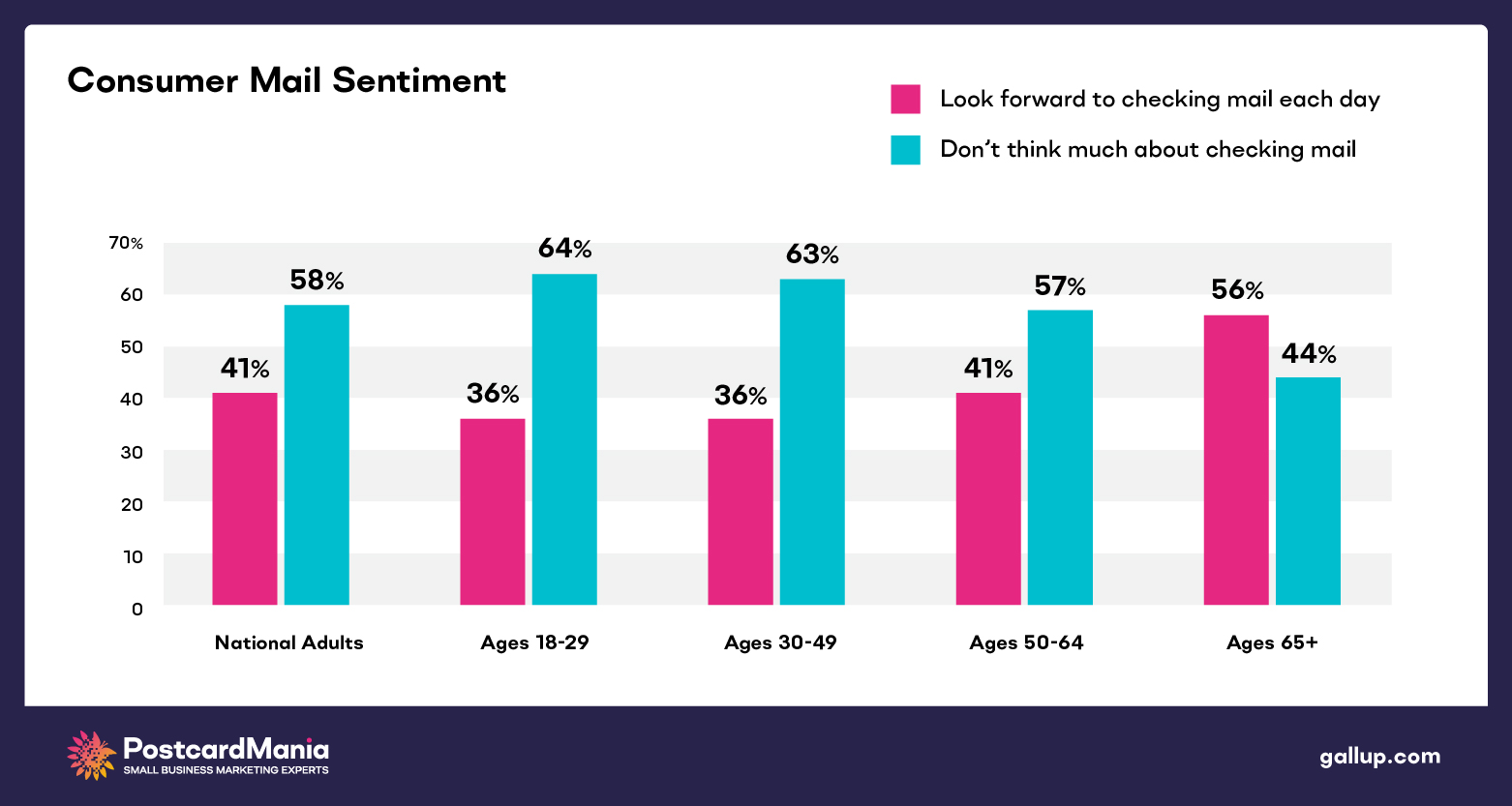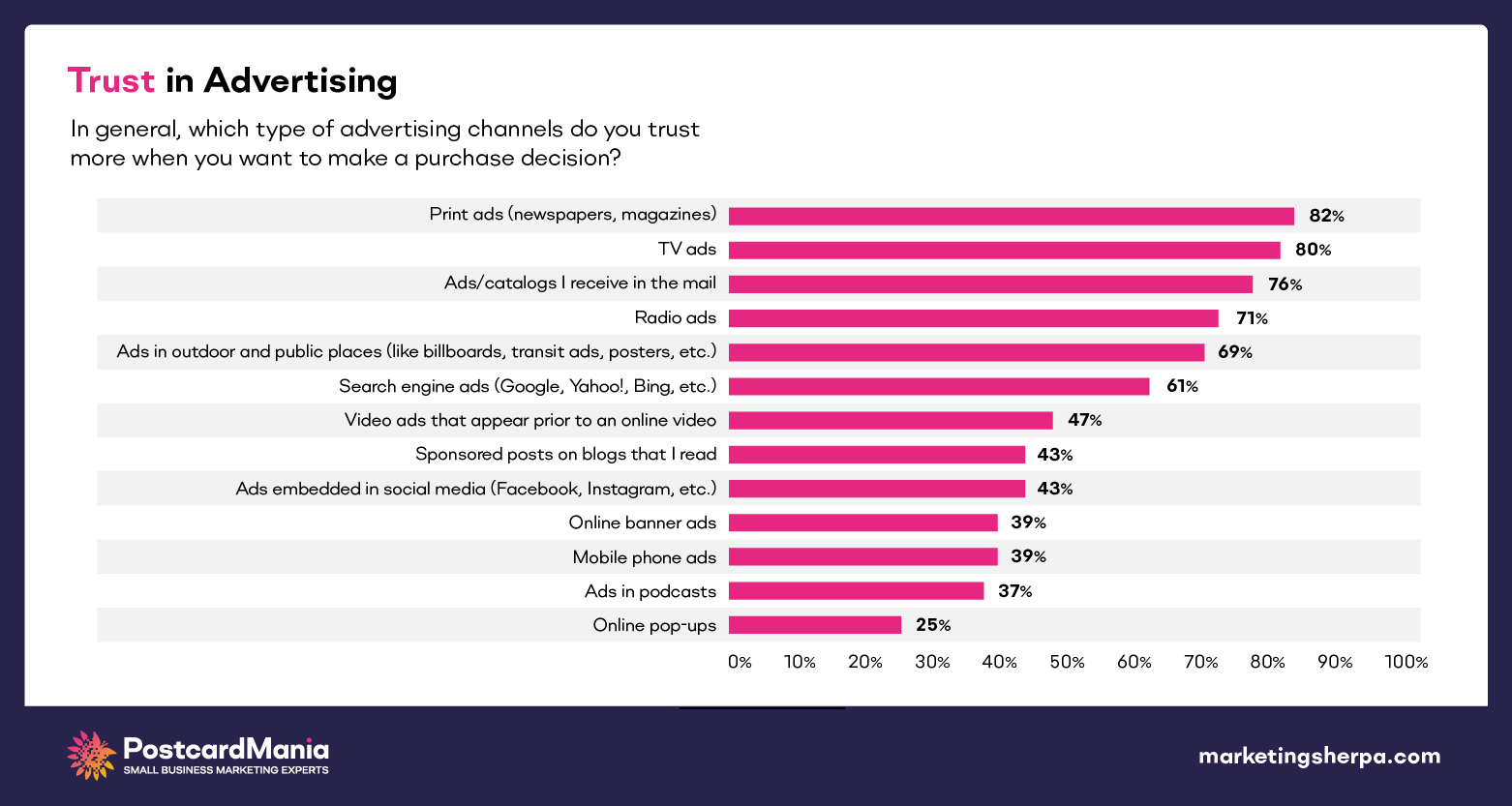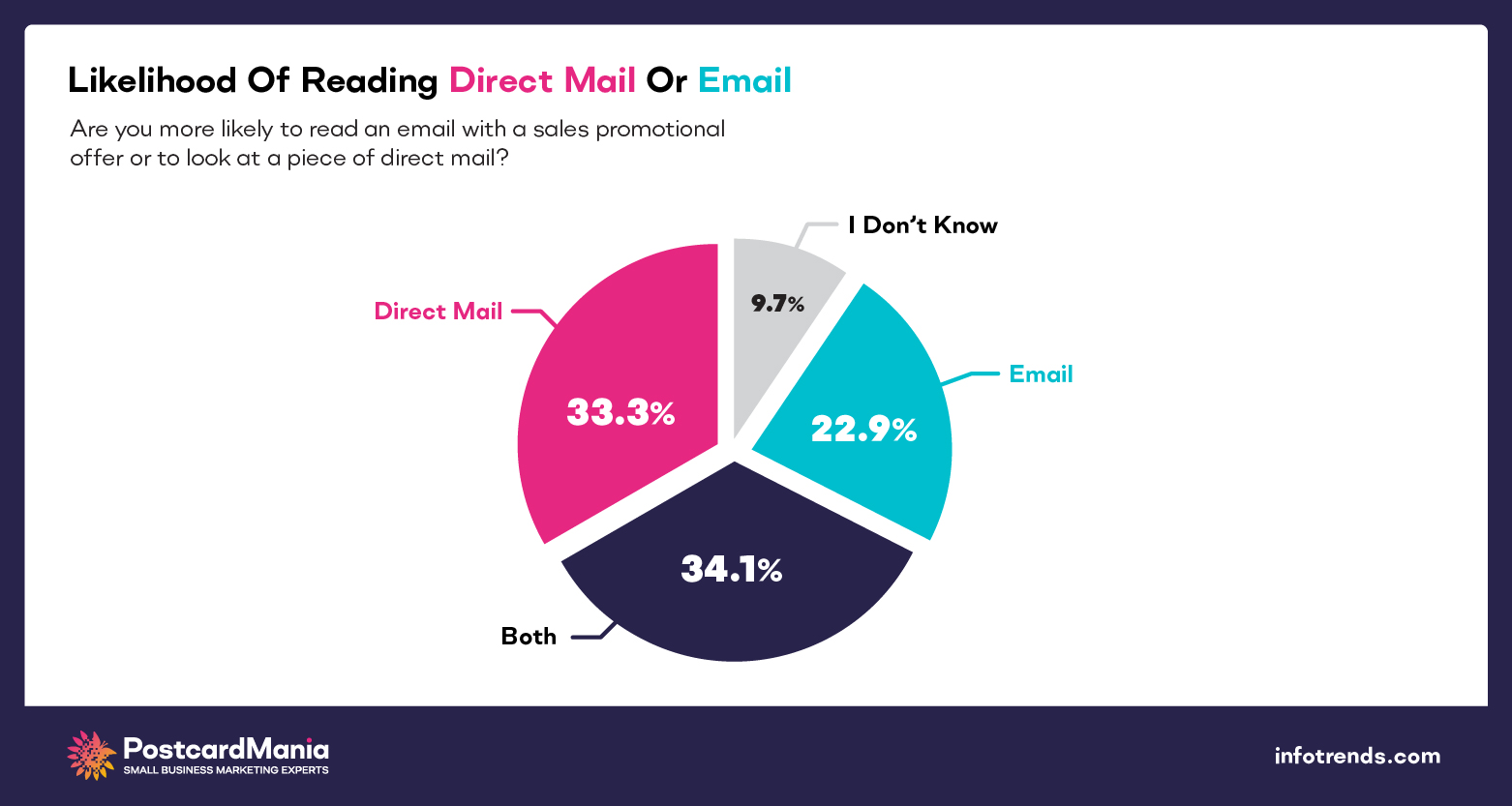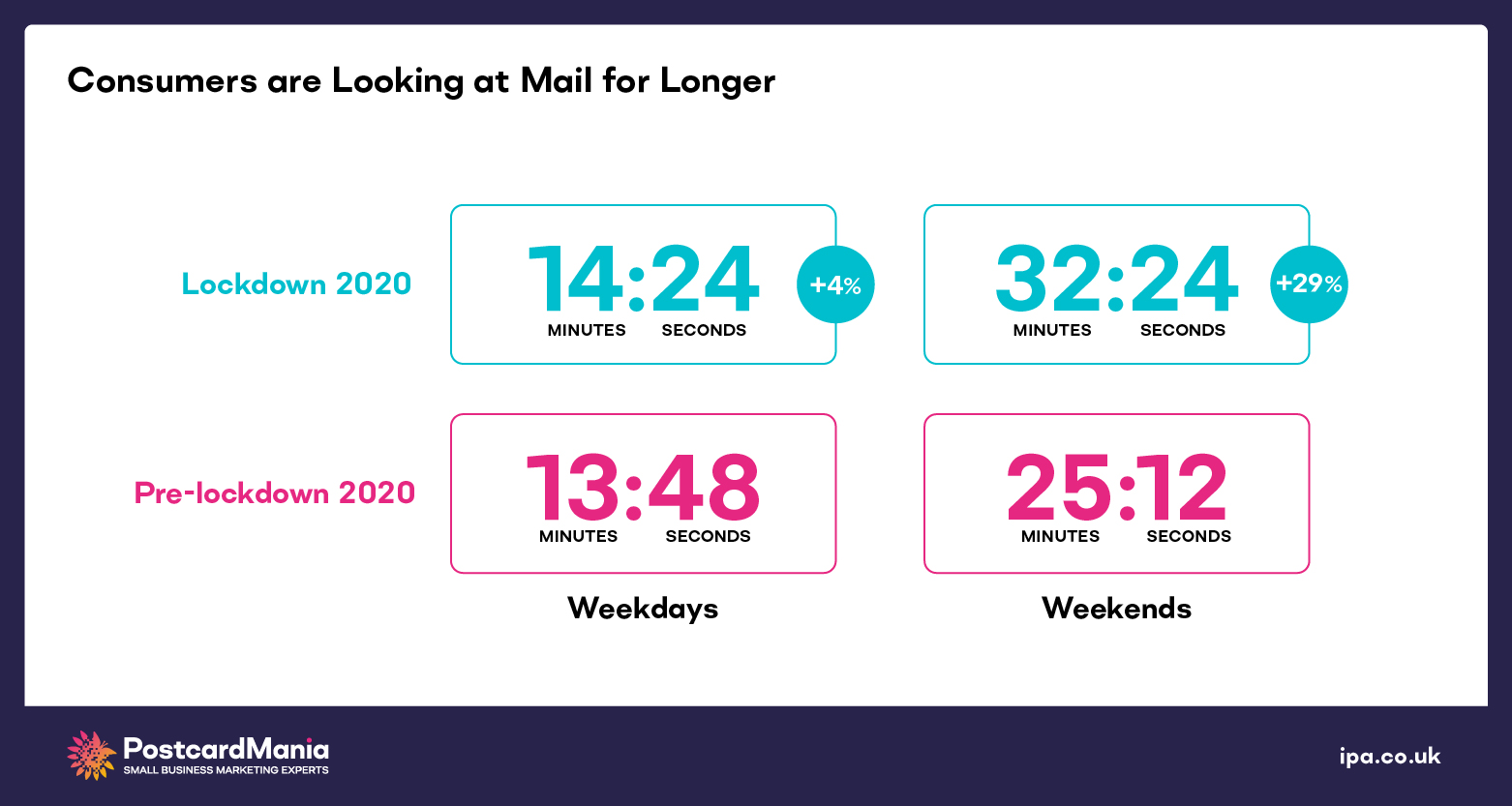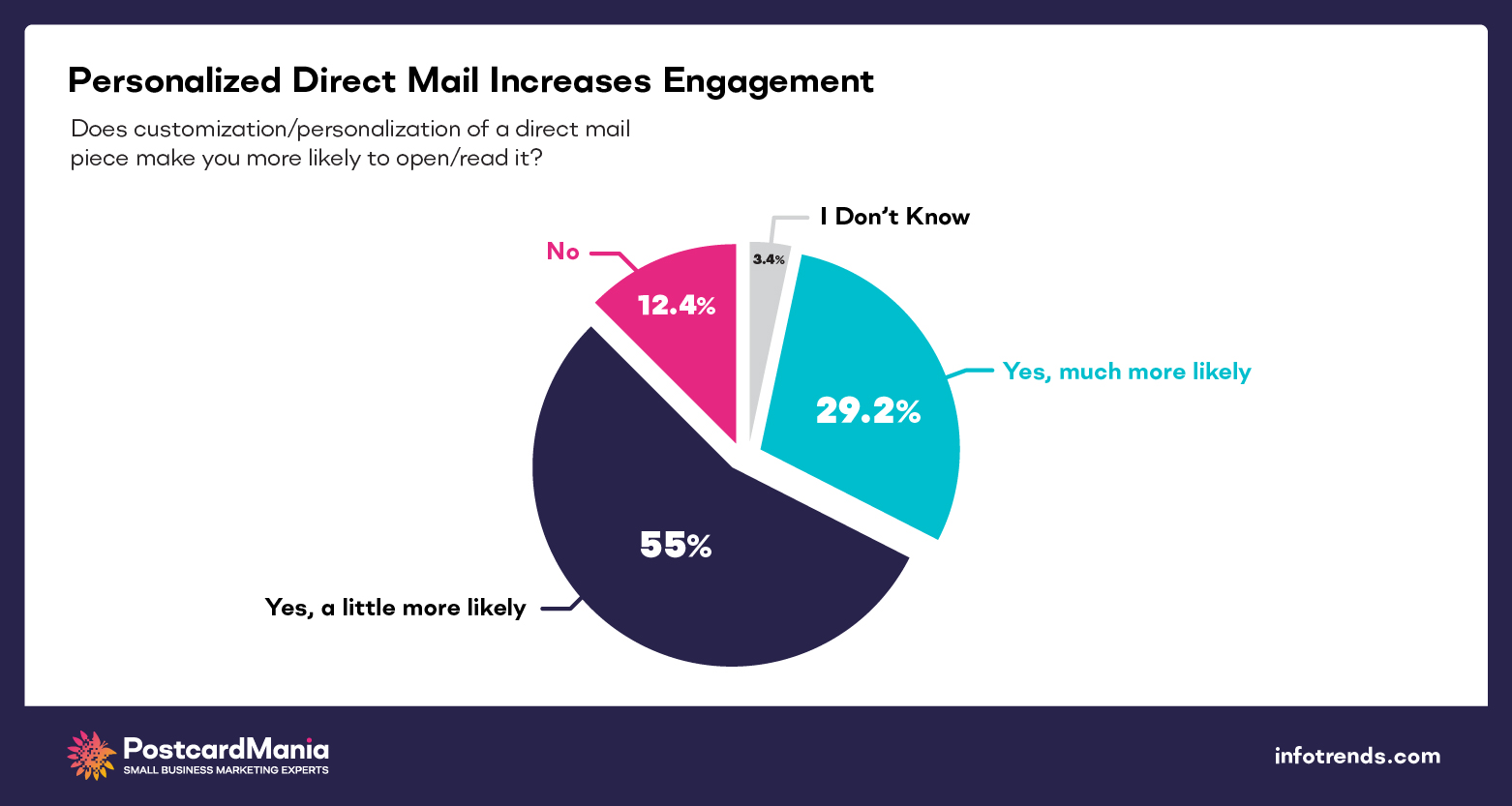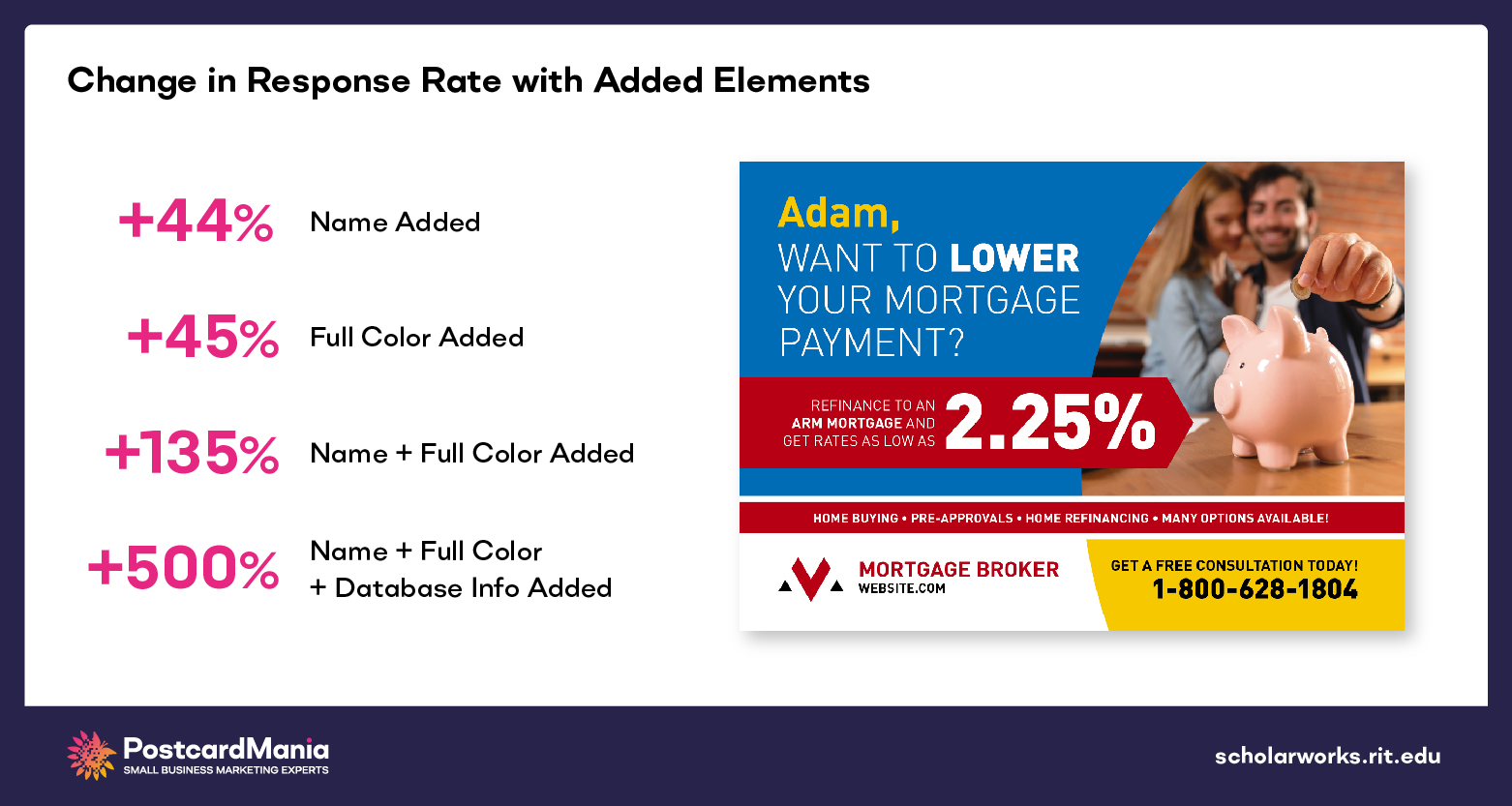What is your impression of direct mail? Most people view it as a bit old school, and while it’s true brochures, flyers, postcards, letters, and the like are the oldest forms of advertising, they aren’t obsolete.
We live in a digital world, but you might be surprised to know that some of the biggest companies in the United States still rely on direct mail to stay connected with their customers, increase leads and increase sales.
For example:
Even Google sends direct mail to bring in new business.
We’ve collected the latest studies and statistics on direct mail to not only prove print is not dead — but thriving. If you need to move the needle on your business’s goals, direct mail marketing is your next best marketing strategy.
You might be shocked by what the data reveals!
Looking for specific direct mail stats? Jump right to the section you want:
Rocket Print & Mail and PostcardMania’s Direct Mail Statistics
Direct Mail Efficacy According to Age Demographics
Direct Mail Return on Investment (ROI)
Direct Mail Sentiment: How consumers feel about direct mail
Direct Mail Adoption: How businesses large and small use direct mail
The Science Behind Direct Mail’s Effectiveness
Direct Mail and Digital Integration
Direct Mail Automation and Retargeting: How new technologies are changing mailers
Taking Action: How to get started with direct mail marketing
Rocket Print & Mail and PostcardMania’s Direct Mail Statistics
So, who are we exactly? You can always read more about us and our parent company here, but the short version is that we’re an $83.9 million marketing company with 115,838 clients specializing in direct mail-led campaigns. That means we have a lot of direct mail experience to share. Below you’ll find key industry insights and trends based on our own unique data that you won’t find anywhere else.
- More businesses are choosing direct mail. Between 2010 and 2019 (over 9 years), our average weekly mail volume increased 104%. In 3 short years, (between 2019 and 2022) average weekly mail volume increased 46%.
- Businesses are also mailing more. So far in 2022, we’ve mailed an average of 3.1 million mail pieces a week, a 15% increase over 2021.
- Mail volume is outpacing digital impressions in growth. In 2021, ad impressions across Meta (formerly Facebook’s) family of apps increased 10% year over year. In 2021, our total mail volume increased 28% year over year.

- More businesses are choosing Rocket Print & Mail and its parent company, PostcardMania, for direct mail. Our earnings grew 31% in 2021, from $64.2 million in 2020 to $83.9 million in 2021. In the previous decade, earnings grew an average of 5%. (You can see the jump in the graph above.)
- New direct mail technologies are growing fast. Our fastest-growing services and products fall under PCM Integrations, a newly formed division that oversees technology-driven partnerships and direct mail automation. PCM Integrations’ revenue grew 154% in 2021.
- Direct mail is still growing in 2022. Our first quarter (Q1) of 2022 was up 18.33% over Q1 of 2021, jumping to $23 million in earnings from $19 million.
- In May 2022, PostcardMania hit a single-week, highest-ever in sales at $2.64 million, 53.28% higher than our previous record of $1.72 million set in November of 2020.
We pride ourselves on results-based campaigns that help small business owners eliminate the oftentimes costly process of marketing trial and error.
We’ve published more than 700 case studies about successful direct mail campaigns for over 50 different industries, offer free samples and design templates, and provide free marketing advice regardless of whether a business ever chooses to work with us or not.
Both younger and older demographics still view direct mail as valuable.
You’d think that Millennials and Gen Z would prefer digital media over printed advertisements, but the data surprisingly reveals this is not the case! Both older and younger groups responded overwhelmingly well to direct mail and said it influenced their buying behavior.
GENERATION Z (born between 1997 and 2012):
- Direct mail particularly resonates with Gen Z because they have grown up with digital messaging, and mail presents something unique to them. MarketReach (2021)
- 72% said they would be disappointed to no longer receive mail and say they are excited to discover what the mail brings every day. USPS (2021)
- The response rate for direct mail among people ages 18-21 is 12.4% compared to a .12% response rate for digital ads. The Data & Marketing Association (2018)
MILLENNIALS (AKA Generation Y, born between 1981 and 1996):
- Millennials have the best perception of retargeted direct mail, and 64% said they would be likely to read it. USPS (2021)
- 47% of Millennials went to a brand’s website after receiving direct mail, which was the highest percentage of all age groups. USPS (2021)
- 82% of Millennials view print advertisements as more trustworthy than digital ads. USPS (2019)
- 62% of Millennials say they tend to read advertising mail they receive, rather than discard it without reading, whereas 33% said they use online ad blockers. USPS (2019)

- 62% of Millennials said they had visited a store in the past month based on information received in the mail—more often than Gen-Xers or Boomers. USPS (2019)
- 75% of Millennials said receiving personal mail makes them feel special. USPS (2019)
- 66% of Millennials bring marketing mail into retail stores. USPS (2019)
- 67% of Millennials use marketing mail as a prompt to go online. USPS (2019)
- 49% of Millennials prefer to shop at stores that advertise to them through the mail. USPS (2019)
- 40% of millennials regularly purchase items featured in marketing mail. USPS (2019)

- When asked which form of marketing encourages people to take action, 30% of millennials went with direct mail and 24% went with email, even about the unwelcomed offers of companies. InfoTrends (2016)
GENERATION X (born between 1965 and 1980
- 68% of Gen-Xers used coupons they received in the mail. Vericast Consumer Intel Report (2021)
- 70% of Gen-Xers are excited to discover what the mail brings every day. USPS (2021)
- According to the Pew Research Center, Generation X is projected to outnumber Boomers in 2028. Since they are the “middle child” of generations, they are not only purchasing items for themselves but also their parents and kids. Hence, direct mail has a potentially larger impact on their spending. Pew Research Center (2020)
- According to Creative Director of Polaris Direct Amber Jodoin, Generation X is unique in that it played a critical role in emerging technologies, yet remembers the world prior to the digital revolution. As such, this generation is digitally savvy, yet also continues to appreciate traditional media, like direct mail. Polaris Direct (2019)
- 60% of Gen-Xers pick up the mail at least 6 days a week in comparison to 44% of Millennials. USPS (2018)
- Generation X is more brand-loyal. 50% said they are extremely loyal whereas 14.6% said they are willing to try new brands, and over 80% said they like joining loyalty programs and receiving discounts from their favorite brands. CrowdTwist (2015)
BABY BOOMERS (born between 1946 and 1964)
- More than any other generation, Boomers prefer to read promotional deals and communications via direct mail rather than digital forms like email. 50% said they preferred direct mail. USPS (2021)
- 2/3 of Boomers have a better impression of a brand that sends out direct mail, and 1/3 of Boomers visited a brand’s website after receiving relevant marketing mail. USPS (2021)
- 89% of Boomers expect and look for special offers in the mail; coupons/deals are the most effective element for them on direct mail pieces. USPS (2021)
- Boomers felt catalogs, advertising cards, or flyers in the mail influenced their purchasing decision the most over ads on social networking platforms, email, or TV ads. Online video ads ranked among the lowest at 3%, while direct mail and recommendations from family and friends were among the highest at 30% and 28% respectively. Marketing Charts (2015)

- Americans 65 and older are more likely to enjoy checking their mail, ranking the highest at 65%. Gallup (2015)

Direct mail has a higher response rate than other forms of advertising.
Did you know the USPS reports the average household receives 7,750% more emails than mail pieces per day — an average of 2 direct mail advertisements as opposed to 157 emails a day? In today’s digital landscape, more people are becoming overwhelmed by the massive influx of digital ads and are ignoring them more often. The stats show people are now more receptive to receiving direct mail marketing than ever before.
- Direct mail has an average engagement rate of 95% and is interacted with at least 4 times at home. MarketReach (2021)
- Direct mail case studies grouped by WARC showed 70% of people were driven toward an online activity by direct mail, and 35% of consumers made a purchase as a result of direct mail. MarketReach (2021)
- Direct mail is read more often than email among all age groups, and 71% of all consumers are excited to discover what the mail brings every day. USPS (2021)
- A record 96% of all mail was engaged with. This is an increase from 2019 which was at 91%. JICMAIL (2020)
- 75% of business mail stays in the home for over four weeks and is revisited an average of 5 times. MarketReach (2020)
- Direct mail response rates are 5 to 9 times higher than any other advertising channel. The Data & Marketing Association (2018)
- 39% of consumers try a business for the first time because of direct mail. The Data & Marketing Association (2018)
- In 2018, the average American household received 454 pieces of mail. The study revealed that 57% of consumers opened addressed mail envelopes, 48.5% looked at what it is, 24.5% kept it to read later, and 1.6% of the recipients put them in the open for display. USPS (2018)
- Direct mail’s average response rate increased from 2.9% to 4.9% for prospects lists and 5.1% to 9% for house lists (current customers/database) between 2017 and 2018. The Data & Marketing Association (2018)
- When compared to email, paid search, and social media, household mail has a higher response rate at 9%, with the former being only at 1%. The Data & Marketing Association (2018)
- A whopping 31% of all mail items were still at home a month after they were delivered. JICMAIL (2018)
- One study asked 1,200 consumers which advertising channels they trusted more. 76% of the group said they trust direct mail (postcards, catalogs, etc.), which is just 6% less than the leading group that trusted ads in newspapers and magazines. Marketing Sherpa (2017)

- 42% of recipients read or scan the direct mail they receive. The Data & Marketing Association (2016)
- 56% of consumers who responded to direct mail went online or visited a physical store. InfoTrends (2015)
- 62% of consumers who responded to direct mail made a purchase. InfoTrends (2015)
- 66% of direct mail is opened, and 82% of direct mail is read for a minute or more. InfoTrends (2015)
- 3% of people in one particular study said they were more likely to read direct mail than open and read emails, while 22.9% said they leaned toward reading emails. InfoTrends (2015)

Direct mail has a higher return on investment.
People may report they like receiving direct mail more than emails, but does direct mail move the needle on conversions? The data shows direct mail has a significant influence on how much profit businesses generate, and the return on investment is well worth the time and effort.
- In one PostcardMania case study, a dermatologist mailed 12,000 postcards to residences in their local area and made $22,500 in profit, more than doubling their ROI of 239%. PostcardMania (2022)
- Respondents reported an 18% greater ROI when marketing campaigns incorporated direct mail. Marketing Charts (2020)
- 25% of people bought something as a result of receiving mail in the past 12 months. Royal Mail MarketReach (2020)
- 4 out of 10 people (40%) responded to direct mail and donated online. Dunham + Company (2020)
- 65% of households with incomes of $100k or more said they made a purchase in the past 30 days because of direct mail advertising. Valassis (2020)
- Over 60% of marketers say direct mail has the highest ROI. Compere Media (2019)
- Direct mail recipients purchased 28% more items and spent 28% more money than people who didn’t get the piece of direct mail. USPS (2018)
- A third of mail pieces led to some kind of commercial action, and a third of them were shared with other people. JICMAIL (2018)
- A Brand Science review of multi-channel campaigns concluded that when mail was included in the marketing mix, campaigns had a 12% bigger ROI than those without mail. Royal Mail (2017)
- Direct mail generates 10% more customers than email (34% direct mail, 24% email). Direct Marketing Association (2016)
- 62% of consumers who responded to direct mail in the past 3 months made a purchase. InfoTrends (2016)
The majority of people view direct mail in a positive light, as opposed to other forms of marketing.
So how do people really feel about direct mail? Most people say they like it! These statistics report consumers’ reactions to advertisements in their mailbox, which are mostly positive.
- Consumers are looking at mail longer. Pre-lockdown times were at 13 minutes and 48 seconds during the weekday, and 25 minutes and 12 seconds on the weekend; post-lockdown times were at 14 minutes and 24 seconds during the week and 32 minutes and 24 seconds during the weekend. MarketReach (2021)

- 87% of people consider mail to be believable compared to 48% for email. MarketReach (2020)
- 70% of people said mail, rather than email, gave them a better impression of the company that sent it. MarketReach (2020)
- 70% of consumers say mail makes them feel valued as a customer. MarketReach (2020)
- 70% of consumers prefer traditional mail for cold, unsolicited offers. The Data & Marketing Association (2018)
- 54% of consumers surveyed said they want to receive mail from brands they’re interested in. Marketing Sherpa (2017)
- A study called “The Private Life of Mail” revealed that 60% of people reported that direct mail had a more lasting mental impression on them. MarketReach (2015)
- In the same study, 57% also said that postcard marketing makes them feel more valued and creates a more authentic relationship. MarketReach (2015)
- 60% of consumers said direct mail makes more of an impression than any screen-based advertisement. MarketReach (2015)
- 4 out of every 10 Americans look forward to checking their mail every day. Gallup (2015)
- Direct mail can generate positive emotional responses from recipients. 66% of audiences reported it was the right way of informing, and 48% understood what was relevant to them and what was not. MarketReach (2015)
Direct mail makes a more lasting impression on consumers.
Believe it or not, there is scientific proof to show why direct mail is so great. Evidence reveals consumers not only trust direct mail more because of the unique way our brains interact with paper-based advertisements, but they also recall the direct mail pieces more because they activate parts of our minds that control emotion.
- A scientific study revealed that it takes consumers 21% less cognitive thinking to process direct mail pieces than digital marketing. Canada Post (2016)
- In a test that compared the impact of similar direct mail and digital media marketing campaigns, participants’ recall was 70% higher when they were exposed to direct mail versus a digital ad, which had a recall of 44%. Canada Post (2016)
- Researchers found direct mail held participants’ attention for 118% longer and stimulated 29% higher brand recall than digital advertising. Canada Post (2016)
- Direct mail has a more significant emotional impact than digital ads, resulting in a stronger recall up to one week later. USPS (2015)
- The study, “Enhancing the Value of Mail: The Human Response” used eye-movement tracking and biometric measurements such as heart rate and respiration to gauge attention and emotional engagement with both digital and direct mail. It also captured brain activity when asked to recall an ad. The results showed participants experienced more excitement and desire for the valued items when interacting with direct mail. USPS (2015)
More businesses are using direct mail and still see it as a viable form of marketing.
In our technologically advanced society, companies big and small are still investing in direct mail and view it as a must-have marketing tactic for amplifying results and ROI.
- Direct mail advertising is currently valued at 9.8 billion in the United States. IBISWorld (2022)
- The direct mail advertising market is expected to reach $73.57 billion in 2026 at a compound annual growth rate of .3%. The Business Research Company (2022)
- Naked Cashmere is a direct-to-consumer retailer that decided to test using direct mail in 2017, and by 2021, direct mail had expanded to 30% of its overall marketing budget. Modern Retail (2021)
- Postcards are the most frequently used type of direct mail by more than half of 580 professionals surveyed between May and June 2020. Marketing Charts (2020)
Marketing campaigns are more effective when digital and print advertisements are combined.
How do direct mail pieces and digital ads affect each other? These statistics show that when direct mail and digital advertisements are combined, the business will yield an even higher response and return on investment!
- Technological advances enhance direct mail’s effectiveness because they have bridged the gap between the print and digital world, offering personalized URLs, QR codes, and AR voice activation techniques to encourage users to interact with the brand. MarketReach (2021)
- When primed by mail, people spent 30% longer looking at ads on social media. JICMAIL (2020)
- Integrated direct mail and digital campaigns elicit 39% more attention than single-media digital campaigns. Canada Post (2016)
- Brand recall peaks when direct mail follows email, outperforming the average for the other single and integrated media campaigns by 40%. Canada Post (2016)
- Marketing campaigns that used direct mail and 1 or more digital media experienced a 118% lift in response rate compared to using direct mail only. Merkle (2015)
Personalized and automated direct mail generates an even greater response.
Technological innovations are transforming direct mail into a modern, fully responsive form of marketing that cuts wasted outreach to optimize budget.
QR codes, automated mailings, and variable data are leading the charge and can even be combined — imagine a campaign that automatically mails a postcard to every new website visitor spending more than 5 seconds on your website without converting (that’s the automation part). The postcard will reach their mailbox in 24-48 hours, and it can be personalized to include their first name, last name, neighborhood, or even product images that coincide with their browsing session (that’s the variable data part) and each postcard will include their own personalized QR code — this ensures full attribution and tracking if they scan their QR and return to your site.
Here are a couple examples of what these mail pieces might look like:



Next-generation direct mail will grab your prospect’s attention, leading to greater response rates. Take a look at the statistics below that prove it!
- 64% of affluent customers say a coupon or discount speeds up their decision to purchase. Vericast Consumer Intel Report (2021)
- 79% of affluent customers say it’s exciting to discover a coupon or discount on a product they were already thinking about buying. Vericast Consumer Intel Report (2021)
- 84% of people in a study said they were more likely to open/pay attention to a direct mail piece if it was personalized. InfoTrends (2015)

- A study by Frank Romano and David Broudy revealed the response rate to direct mail increased by 135% when it was personalized by the recipient’s name and was in full color. When all factors were combined—name, color, and database information—the response rate went up even higher to 500%. “An Investigation into Printing Industry Demographics.” By Frank Romano and David Broudy, Rochester Institute of Technology (2010)

How can I get started with direct mail marketing?
As you can see after reviewing the data, direct mail has not only been proven effective for years, but it is also a growing industry, incorporating new technologies and tactics.
To get started, we recommend you look through our case study library, which contains stories of successful direct mail marketing campaigns.
Click here to view our case study library.
To speak with a marketing consultant and get expert advice on direct mail marketing, call 800-442-0112.


